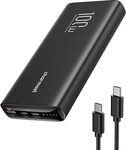Tick the 35% off coupon to bring up the final price of $54.92.
Amazon description:
About this item
✨【Massive 23800mAh Capacity】Compact 23800mAh Power Bank can charges an iPhone 12 Pro max almost 3.5 times,iPhone 12 Pro 4 times, iPhone 12 4.3 times etc.
✨【100W PD Power Fast Charing】The Battery Pack with 100W PD output that can charge most laptops like MacBook/MacBook Pro/MacBook Air, and perfect for some PD phones like iPhones.
✨【18W PD & QC 3.0 Quick Charge】All outports(2 USB C & 1 USB A )support 18W Power Delivery fast charging for devices. You can also charge 3 devices at the same time with there different outputs( total 65W).
✨【45W USB C Power Delivery Input】External Battery Packs supports mighty 45W PD input, to get a full recharge in just 2 hours by 45W PD 3.0 power adapter(Not included), 18W USB C PD/QC 3.0 power adapters in just 6 hours, standard 5V-2A power adapter in just 11 hours.
✨【Low Current Charging & Certified Safe】Advanced Low-Current Charging Feature, especially perfect for low current(below 60mA) wireless bluetooth earphones. Built-in safeguards protect your devices against excessive current, overheating, and overcharging.Can be used on Plane.



 CamelCamelCamel
CamelCamelCamel

Massive 23800mAh Capacity in the description, 20000mAh in title